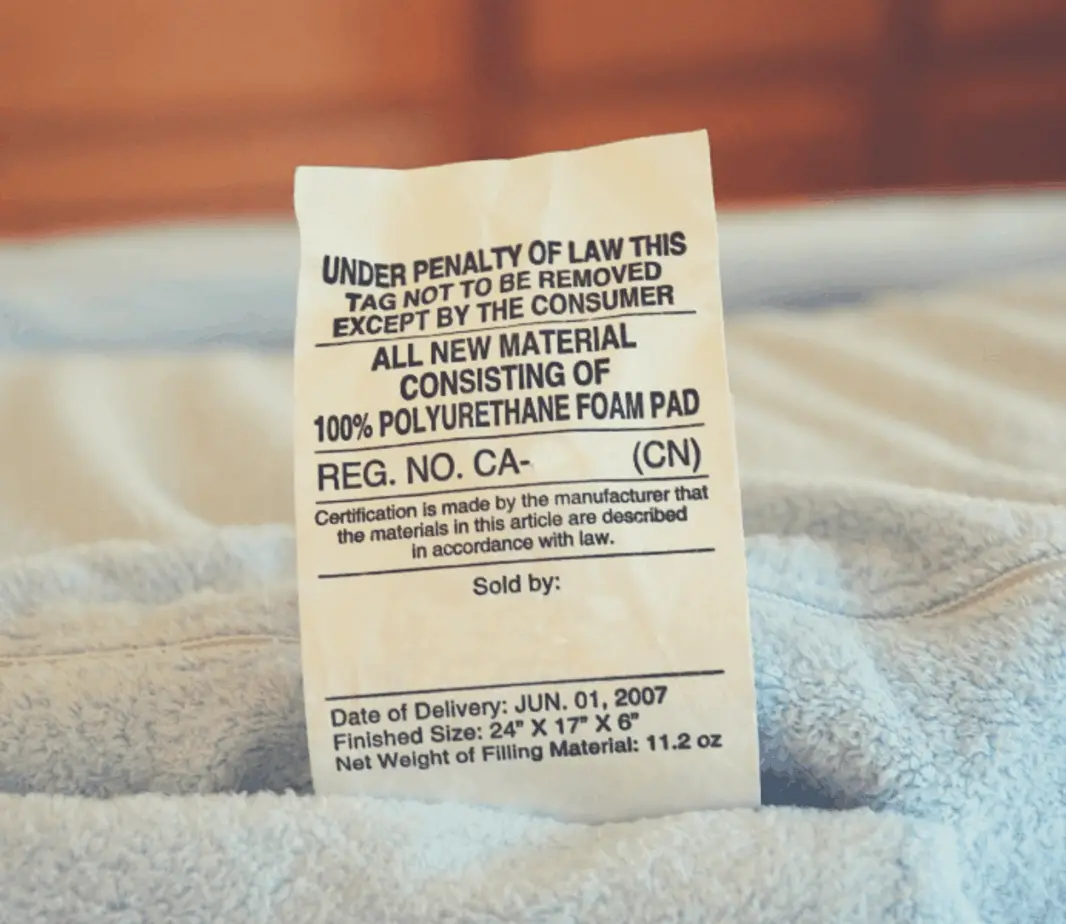Whether you own an old mattress or just ordered a new one, you’ve probably come across the infamous “Do Not Remove Under Penalty of Law” tags.
This can be very confusing especially when you have just shelled out hundreds or even thousands of dollars on a brand new mattress yet can’t do as you please with it.
Why do mattresses have tags?
Well, mattress tags are designed to inform the consumer of the raw material content in a particular model. This ensures that you can order with full knowledge of what comprises your mattress.
Who Are the Mattress Tags Aimed at and Why?
Many consumers dutifully keep their mattress tags on as specified and check on them routinely to ensure they’re still there. After all, nobody wants to face any legal troubles over their mattress right?
Well, not exactly! As scary as those warnings may sound, it is important to know that they’re not meant for consumers. Unless you plan to resell the mattress in the future, you have absolutely no obligation to keep those mattress tags.
You can decide to keep or get rid of them at your pleasure. Thus, there’s no need to fear prosecution or legal fines if the tags are removed for one reason or the other.
We’re glad to have cleared up the confusion. But, if consumers can do as they please with their mattress tags then why is there a warning against removing the tags?
Well, the mattress tag warnings are strictly meant for manufacturers and retailers for the benefit of consumers. It is a deterrent to ensure the provision of accurate information about the material content of each mattress so consumers can make well-informed decisions.
History of Mattress Tags
The mattress industry boomed around the latter parts of the 1800s and early 1900s. However, manufacturers began to cash in on the boom by stuffing their products with unsavory and illegal materials.
From horse hair to even food waste, these greedy manufacturers found ways to stuff their products with anything they could come across. This led to significant dents in the quality of sleep such mattresses could provide.
But more importantly, the use of unforgivable stuffing materials for mattresses began fueling the spread of communicable diseases such as Small Pox and Tuberculosis- 2 common infections caused by bacteria.
This led to several deaths caused by such infections. In a bid to end that trend and safeguard the lives of citizens, government authorities stepped in by enacting laws that required that every mattress featured tags that revealed the raw material components.
This law stifled the illegal mattress stuffing industry and nearly brought it to a halt. But, the players were not prepared to go down without a fight.
They responded by removing tags or destroying them to deceive consumers into buying mattresses they would otherwise not due to the use of mediocre components.
The government responded to that development by making laws that made it illegal for mattress tags to be removed in any capacity.
Penalty for Removing Tags
Now that we know that the “Do Not Remove Under Penalty of Law” mattress tags are meant for manufacturers and retailers, it is only natural that you’d want to know what the penalties for flouting the rules are.
Firstly, every state has different punishments for disregarding this rule ranging anywhere from simple Cease and Desist Orders to monetary fines. First-time offenders are likely to have lenient sentences compared to repeat culprits of this law.
Additionally, consumers can always sue mattress makers and retailers who remove tags or destroy them in any way to conceal the contents. This can result in monetary damages running into several hundred or thousands of dollars.
Benefits of Tags
Tags play a vital role in the consumer mattress industry. Just like packaged food items feature a list of ingredients in their specific quantities, the presence of tags can come in very handy.
Here are a couple of reasons why mattress tags should always be kept in mint condition by manufacturers, retailers, and even consumers.
1. Stay On the Right Side of the Law

Keeping your mattress tags in a good condition means staying on the right side of the law as a mattress maker or retailer. Tags are one of the important checks inspectors make during showroom and factory visits.
Hence, following federal and state guidelines about these tags can give you the peace of mind to operate your business. It can also eliminate the risk of getting sued by the government or consumers due to tag tampering.
Keeping the tags in good condition can also enhance your reputation among consumers. This may lead to several referrals that can boost your business overnight.
No matter how much you’re tempted to mess with tags, it is important to stay clear of them. Remember, the negatives can outweigh any positives you could derive from the illegal act as a retailer, manufacturer, or second-hand mattress dealer.
2. Allows Consumers to Make Well-Informed Decisions
Consumers deserve to know exactly what they’re getting themselves into whenever they shell out money on any goods and mattresses are no exception.
Tags display the actual component of each mattress in terms of the type of foams used as well as coiled springs styles if applicable. They also feature the exact quantity of each component in question so you can be under no illusions of what’s in store when the mattress finally arrives.
Tags cannot only help you choose the right type of mattress but can also make the search process easier. For instance, hot sleepers can choose models that feature breathable components to ensure amazing nights even during the summer.
I personally sleep on the Vibe 12-inch Memory Foam Mattress from Amazon. It feels super cozy, provides cool sleeping during the summer, and offers superior comfort for my girlfriend and me.
3. Prevents Spreading of Bacteria

Bacteria can spread easily from person to person when distasteful materials are used to stuff mattresses. Remember, that is one of the reasons why tags were invented in the first place and the same reason holds true today as it did back in the 19th and 20th centuries.
The use of tags forces manufacturers to practice the highest sanitation to prevent the spreading of infections and diseases.
Thanks to these tags, anyone can boldly order any mattress of his or her choosing and be confident of minimal risk of exposure to diseases such as tuberculosis and smallpox.
4. Prevents the Use of Unsavory Raw Materials
More often than not, consumers never set their eyes on the components of the mattresses they purchase. They simply order whatever model looks appealing and use it until the point where sagging, indentations, or other quality problems set in.
At that point, consumers discard the old mattress and invest in a new one to sleep well again. As such, without tags, manufacturers can be easily tempted to integrate cheap materials that may not be good for short-term or long-term consumer health.
Thanks to the tag enforcement rules, manufacturers now have no choice but to indicate the specific material components of each mattress model released onto the market.
Since consumers are more enlightened about the level of comfort different materials may provide, brands are being forced to utilize the best on the market.
Besides, mattress makers also try to outdo their competitors by using the best raw materials in the industry. All of these developments continue to benefit consumers by ensuring that they can take their pick of the best mattresses on the market.
5. Makes it Easy to Resell Your Mattress
Selling your old mattress is no piece of cake. It can take a lot of work to be able to flip a pre-owned mattress successfully.
Sure, you can expect potential buyers to offer prices that may be only a small fraction of the purchase price regardless of how good your mattress may look.
But, every discerning buyer would demand that the tags are not only present but clear to read with absolutely no ambiguity. Remove the tags from the mattress and you can practically kiss the chances of selling it goodbye.
Whether you’d love to resell your mattress soon or donate it to Goodwill and other charities, it is important to keep the tags in a good condition.
How to Reattach Torn Mattress Tags
So you’ve accidentally torn the tags on your mattress and want to fix it back? Here’s a simple step by step instructions to follow.
- Pick up the torn tag
- Apply glue on the opposite side of the “do not remove tags” inscription
- Fix the tag on the previous spot
- Run your hands firmly on the attached tag until it dries
Frequently Asked Questions
Have any further questions about mattress tags? You’ll likely find them below as we provide detailed answers about the most common questions people ask.
Does removing mattress tags void the warranty?
The answer is yes. Removing the tags automatically voids the warranty in any mattress whether brand new or pre-owned. If you want to maintain the right to file for a warranty, we recommend keeping the tags on at all costs.
Where is the mattress tag located?
Different mattress makers place tags at different locations but a quick inspection should help you find it. Remember, tags are usually placed in conspicuous places such as the end of the mattress so locating it shouldn’t be a problem.
Do Pillows have tags too?
Yes, several pillows on the market have “do not remove” tags so pay attention and make sure to keep those tags intact if you own one of those.
Conclusion
Congratulations on reading our detailed guide about why the critical role mattress tags play up to this point. You now know that it is important to maintain those tags whether you’re a manufacturer, retailer, or consumer.
In the event of accidentally peeling off the tags, you can follow the step by step instructions above to reattach it as soon as possible.
You wouldn’t want a legitimate warranty claim to be dismissed based on the absence of tags, would you?
